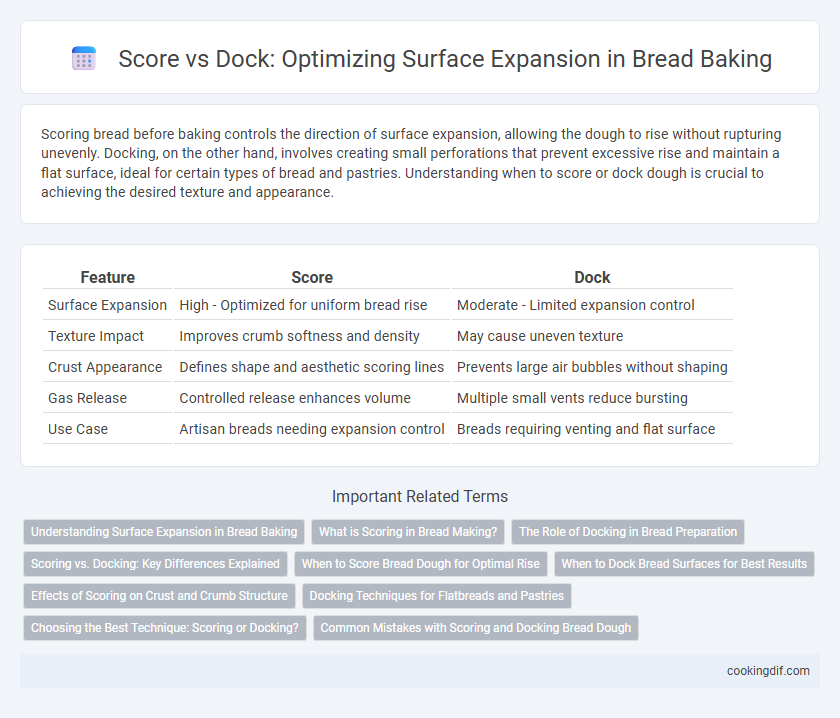Scoring bread before baking controls the direction of surface expansion, allowing the dough to rise without rupturing unevenly. Docking, on the other hand, involves creating small perforations that prevent excessive rise and maintain a flat surface, ideal for certain types of bread and pastries. Understanding when to score or dock dough is crucial to achieving the desired texture and appearance.
Table of Comparison
| Feature | Score | Dock |
|---|---|---|
| Surface Expansion | High - Optimized for uniform bread rise | Moderate - Limited expansion control |
| Texture Impact | Improves crumb softness and density | May cause uneven texture |
| Crust Appearance | Defines shape and aesthetic scoring lines | Prevents large air bubbles without shaping |
| Gas Release | Controlled release enhances volume | Multiple small vents reduce bursting |
| Use Case | Artisan breads needing expansion control | Breads requiring venting and flat surface |
Understanding Surface Expansion in Bread Baking
Surface expansion in bread baking refers to the increase in dough area during fermentation and oven spring, which directly affects crust texture and crumb structure. The score, or scoring depth and pattern, controls where and how the bread expands, preventing uncontrolled cracking by directing the surface tension release. A properly executed dock, involving perforations or controlled punctures, helps moderate expansion and moisture release, balancing the loaf's volume and preventing excessive dome formation.
What is Scoring in Bread Making?
Scoring in bread making refers to the intentional slashing or cutting of the dough's surface before baking, which controls the expansion and prevents unpredictable cracking during oven spring. This technique allows the baker to direct surface expansion and create aesthetically pleasing patterns, contributing to both the bread's texture and appearance. Compared to docking, which involves piercing the dough to limit rise and avoid large air pockets, scoring actively guides the bread's growth for optimal structure and crust development.
The Role of Docking in Bread Preparation
Docking plays a crucial role in controlling surface expansion during bread preparation by creating small perforations that allow steam to escape, preventing excessive rising and cracking. Proper docking ensures even baking and a uniform crumb structure, enhancing the final bread texture and appearance. Effective docking techniques contribute directly to improved dough handling and consistent loaf quality.
Scoring vs. Docking: Key Differences Explained
Scoring and docking are crucial techniques for controlling bread surface expansion during baking, with scoring involving intentional cuts on the dough to direct gas release and prevent random cracking. Docking uses small perforations to allow steam to escape, minimizing expansion and creating a uniform texture. Scoring enhances aesthetic appeal and targeted expansion, while docking ensures even baking and surface stability.
When to Score Bread Dough for Optimal Rise
Scoring bread dough before baking controls surface expansion by directing where the crust will crack, allowing steam to escape and promoting an even rise. Optimal scoring occurs after the final proof when the dough is slightly risen but still elastic, ensuring clean cuts that prevent random tearing. Proper scoring techniques enhance oven spring and create an appealing crust texture and pattern.
When to Dock Bread Surfaces for Best Results
Docking bread surfaces before baking prevents excessive expansion and uneven crust formation by allowing steam to escape through controlled perforations. Score patterns direct the bread's rise and aesthetic appeal by guiding expansion along intended lines without compromising structural integrity. Docking is ideal for flatbreads or doughs requiring minimal rise, while scoring suits artisan loaves needing an open crumb and decorative splits.
Effects of Scoring on Crust and Crumb Structure
Scoring bread before baking directs surface expansion and prevents uncontrolled splitting, resulting in a uniform crust and enhanced aesthetic appeal. The cuts allow controlled release of steam and gas, which modifies crumb structure by creating larger, more open alveoli near the scored areas. This technique improves oven spring and contributes to a well-developed crust with desirable texture and color.
Docking Techniques for Flatbreads and Pastries
Docking techniques in flatbreads and pastries involve creating small perforations to control surface expansion during baking, preventing excessive puffing and uneven texture. Proper scoring guides the bread's expansion, resulting in aesthetic patterns and controlled oven spring while docking evenly releases steam to maintain a flat, crisp surface. Combining scoring and docking optimizes texture and appearance, particularly in delicate flatbreads and layered pastries where precise expansion control is essential.
Choosing the Best Technique: Scoring or Docking?
Scoring bread dough creates controlled surface expansion by making shallow cuts that direct gas release and prevent random cracking, enhancing crumb texture and loaf shape. Docking involves piercing the dough to release steam and control rising but can result in denser, less uniform bread with limited aesthetic appeal. For artisan and high-rise bread types, scoring offers superior control over surface expansion, while docking suits flatter breads where controlled perforation is sufficient.
Common Mistakes with Scoring and Docking Bread Dough
Scoring bread dough improperly often leads to uneven surface expansion, causing unpredictable oven spring and undesirable loaf shapes. Common mistakes include shallow or excessively deep cuts, inaccurate scoring angles, and inconsistent spacing, which hinder proper gas release and final crust development. Docking too much can also reduce oven spring, resulting in a dense texture instead of the desired open crumb structure.
Score vs dock for surface expansion Infographic

 cookingdif.com
cookingdif.com